As Environmental Engineering Students and Enthusiasts, it is our duty to practice and advocate ourselves for Environmental Awareness, and to introduce and promote Natural Farming to the society.

Developed by Master Han Kyu Cho, Janong Natural Farming Institute in South Korea:
Korean Natural Farming (KNF) is a sustainable system based on generations of sustainable farming methods practiced in Japan, China, and Korea. The production of plants or livestock is optimized through farming methods that maintain a balance in nutrient input and output, thus minimizing any detrimental effects on the environment.
The soil is recognized as a fundamental natural asset in Natural Farming. Healthy soil is the foundation of sustainable agriculture.However, farming practices differ mainly based on soil inputs and crop protection measures. But, the use of chemical fertilizers and pesticides destroy the beneficial soil microflora, changing the soil nature and also contributing to the high crop production cost.
Minimizing the external inputs to the farmland and nurturing the soil fertility is the essence of natural farming, through the propagation of beneficial soil microbes, the soil has shown enrichment by encouraging the natural symbiosis of soil microflora and crop plants.
What Is Fermented Plant Juice?
The Fermented Plant Juice is used in solutions for seed and soil treatments and plant nutrition.
It consists the young shoots of vigorously growing plants that are allowed to ferment for approximately 7 days with the aid of brown sugar. The brown sugar draws the juices out of the plant material via osmosis and also serves as a food source for the microbes carrying out the fermentation process. The weak alcohol produced during fermentation extracts chlorophyll (soluble in ethanol) and other plant components.
When selecting plants for making FPJ, you need to use the growing tips of plant species that are fast growers. The plants should be vigorously growing at the time of collection. We need to keep in mind the plant chemistry, plant parts should be harvested while the plants are in respiration mode usually before sunrise and not in photosynthetic mode especially during daylight. Also, to conserve the surface microbial populations of plants like lactic acid-producing bacteria and yeasts, which will carry out the fermentation process, avoid collecting the plant parts during or after rainfall (we should wait until two sunny days after rain stops) and do not rinse collected plant parts. Low levels of these microbes will result in improper fermentation and/or low yields of plant juice.
So, What Kinds of Plants Can Be Used to Make FPJ? - Plants should be vigorous, fast-growing, and healthy. For example, young banana trunk, river cabbage, bamboo shoots, etc.
When Is the Best Time to Make FPJ?
FPJ is usually made during the warmer months when plant growth is vigorous and growing tips are abundant.
Do-it-Yourself: How to Make the Conconction of Fermented Plant Juice (FPJ)
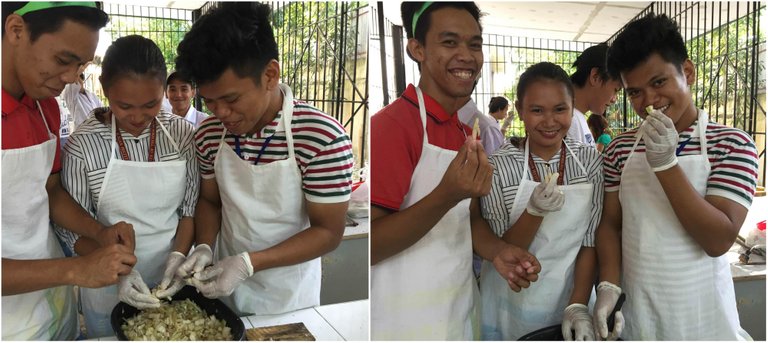
Step 1. Collect plant material
Collect the fast-growing tips (2–3 inches long) of plants. Avoid collecting during or after rainfall.
We collected materials from a young banana trunk.
Step 2. Cut and weigh the plant material
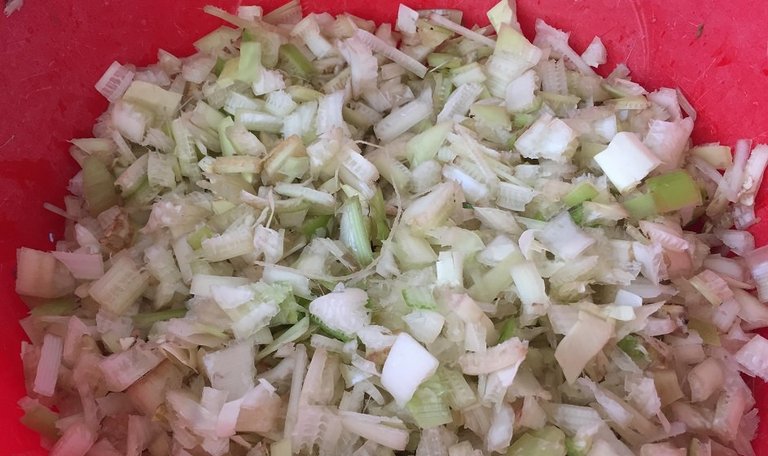
Cut the shoot tips into 2- to 3-inch pieces then weigh 1kg of the plant material.
Remember: Do not rinse collected plant parts to conserve surface microorganisms.
Step 3. Add brown sugar.
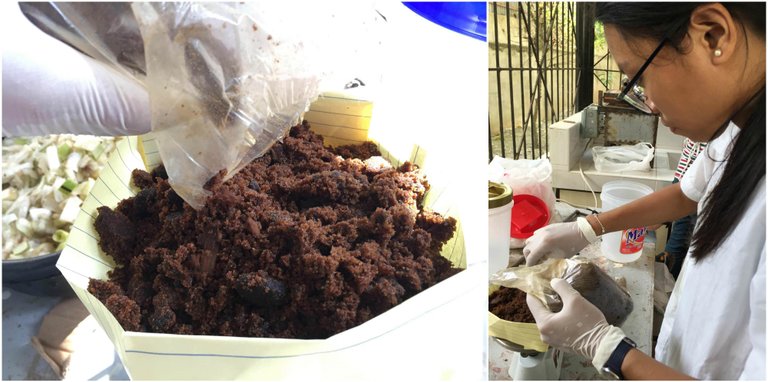
Weigh out 500g brown sugar and toss together in a bowl or large pan. Mix the sugar and plant material to expedite the osmotic process and draw out the plant juices.
Step 4. Pack the plant-material-and-brown-sugar mixture into a container.
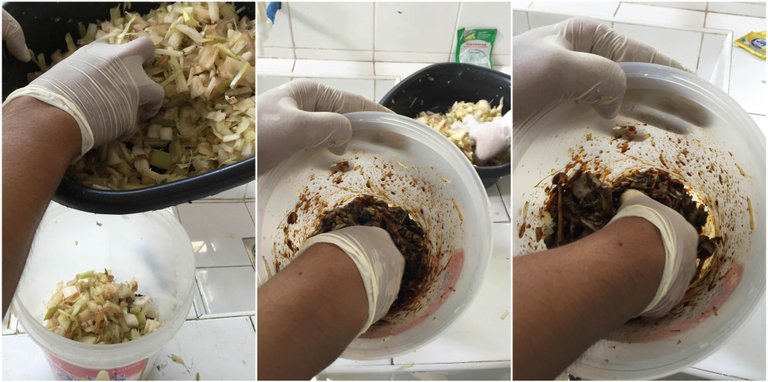
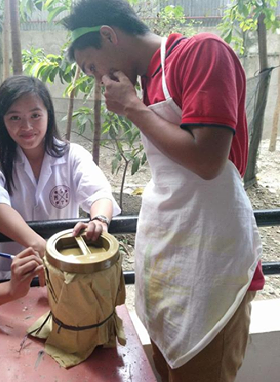
Select a clear glass or food-grade polyethylene (PE) plastic container (no lid necessary). Note: Do not use metal, it will react with the solution. The plant-material-and-brown sugar mixture should be packed tightly in the container. Cover the mouth of the container to keep pests and other contaminants out. Then, store the covered container in a well-ventilated area away from artificial or natural light and extreme heat or cold. Do not refrigerate.
Step 5. Adjust the volume after 24 hours.
In order for the fermentation process to occur properly, the volume of the plant-material-and-brown-sugar mixture should settle to 2/3 of the container after 24 hours. It is important to remove some of the plant material until the container is no more than 2/3 full and if it contains less than 2/3 full, add more of the mixture to prevent mold growth. However, not all plants will settle in the same way, so it is important to check and adjust the volume after the first 24 hours.
We made the concoction just a few hours ago, we will still wait for more hours until adjusting the volume.
Step 6. Let it ferment undisturbed
The fermentation process is dependent on ambient temperature. The best indicator if fermentation is occurring is when bubbles start to form, which normally occurs on the second day. Ideally, fermentation should take no longer than 7 days, as the quality of FPJ appears to diminish thereafter.
Fermentation is complete when
- the plant material floats and the liquid settles at the bottom
- there is a light alcohol smell due to the breakdown of chlorophyll;
- and the liquid tastes sweet, not bitter (if your FPJ is intended for human consumption).
Step 7. Separate the liquid from the solids
After fermentation is complete (3 to 7 days), separate the plant material from the liquid using filter or strainer. The spent plant material can be used as animal feed, or added to mixed compost (another input known as IMO). There you have it, the liquid acquired is the Fermented Plant Juice (FPJ), which can be used immediately or stored in a loosely covered container.
How Is FPJ Used on Plants? - FPJ is diluted with water and applied as a soil drench or a foliar application directly onto plants.
Preparing and Applying FPJ
Dilute FPJ with water - generally, at a concentration of 1 part per 500 parts water (1:500). Apply FPJ once per week in the late afternoon, best if an hour before sunset. The solution can be watered onto plants or into the soil, or it can be applied as a foliar spray. The nutrient solution is applied once per week and is adjusted as the plant passes through its life-cycle stages and vegetative and reproductive phases.
Conclusion
The indiscriminate use of chemical fertilizers and pesticides posed a threat to the soil and environment. Many investigations have shown their adverse effects of change in soil nature, soil contamination, groundwater pollution and a decrease in soil microflora etc. While studies have shown that natural farming, with the minimum external inputs, improves the soil fertility by increasing the soil microflora and available nutrients.
References:
Natural Farming: Fermented Plant Juice by Sherri A. Miller, David M. Ikeda, Eric Weinert, Jr., Kim C.S. Chang, Joseph M. McGinn,Cheyanne Keliihoomalu, and Michael W. DuPonte
https://www.omicsonline.org/open-access/natural-farming-ecofriendly-and-sustainable-2168-9881-1000147.php?aid=80363
http://www.thehindu.com/news/national/andhra-pradesh/%E2%80%98Natural-farming-is-the-best-agricultural-practice%E2%80%99/article14022423.ece

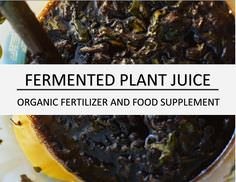
Ang galing naman at nakikita ko na you are working so hard to aim the exact thing or the finished products. I can see the potential in you guys so keep it up, we might not know that in every experiment you made will be more productive and mapagkakitaan niyo pa. =)
Maraming salamat @purepinay. Pag natapos at mas natutunan pa namin ang technique nato, pwedeng pwede itong ituro sa mga magsasaka nating kababayan upang mas makatipid at magkaroon ng masaganang ani. :)
Awesome post :)
Looks like a delicious recipe :D
We made this not suitable for human consumption, rather a natural fertilizer.
Well makes me look like an idiot, must have missed that :/
Lol, it can be consumed as well, but we'll need to make the experiment inside a clean laboratory room with clean bench and sanitized equipment.
I really enjoyed this experiment. Next is FFJ and OHN! Hahahahaha
hahaha ikaw napd blog. mag-IMO papd ko
hahahaha cge pag mag lab nasad ta
Puhon haha kwaa na ang bato ugma
pwede hapon na? hahaha
Hi! I am a robot. I just upvoted you! I found similar content that readers might be interested in:
https://www.ctahr.hawaii.edu/oc/freepubs/pdf/SA-7.pdf
I have used it as a reference for this post. I already cited the Journal which is "Natural Farming: Fermented Plant Juice" by Sherri A. Miller, et al. Thank you @cheetah.
woooooooow shaiiii. patudlo ko bi hehehehehehh